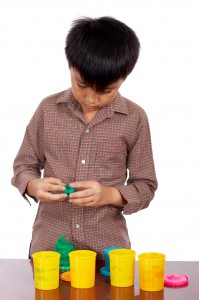
Play dough is an old favourite but a great activity that is cheap and kids can learn so much from it. Your child can learn action words, concepts of size, shape, texture and colour, develop pretend play skills and develop hand skills in preparation for writing, all while having fun.
You can buy playdough from toy shops and supermarkets quite cheaply or you can make your own. Making it is fun and cheap and your child can help with the making process. Be careful though if your child eats playdough, as the high salt content can be dangerous for young children. If you think your child may put it in their mouth or eat it, choose non toxic playdough from the shops and always supervise your child carefully.
Here is a recipe to make your own
Uncooked Play Dough
- 2 cups of plain flour
- 4 tablespoons of cream of tartar
- 2 tablespoons of cooking oil
- 1 cup of salt
- 2 cups of boiling water
- food colouring
Put it all in a bowl and mix well. Tip it out on a bench and kneed until smooth.
You can also add glitter for colour or sand for texture or essential oils such as lavender or peppermint for a delicious scent. If you want to make a couple of different colours choose colours that look nice when mixed together, as this is sure to happen. Red (or pink) and blue will make purple, yellow and blue will make green, but red and green will make something that looks pretty awful. Keep your playdough wrapped tightly in cling wrap in the fridge.
As you play with young children talk about the different actions you do as you roll, pat, squeeze, cut, squash, slice. With preschoolers and school aged children try using different things from around the kitchen to make shapes and patterns and talk about the shapes and textures that you make. Use a tea set or toy cooking set to do some pretend play. You could be a chef or have a restaurant or just have some teddies around for afternoon tea. You can make balls and sausages and talk about concepts; such as long, short, thick, thin, heavy, light, big, little, middle sized. You could try comparatives and superlatives; big, bigger, biggest, long, longer, longest. You can also practice counting skills. Why not make letter shapes either by rolling sausages and shaping the letters or by using alphabet shaped cookie cutters or stencils. Start with your child’s name and then try other letters or words to develop phonological awareness skills. Make a simple word then change the first letter to help your child understand rhyming. All that pushing and squeezing develops muscle strength and control in little hands and fingers to help prepare for writing too.
Have lots of fun!
Related Blog Posts
If you liked this post you may also like:
Give books for Xmas
Asking Questions
10 waiting room skills
Why kids need play!



